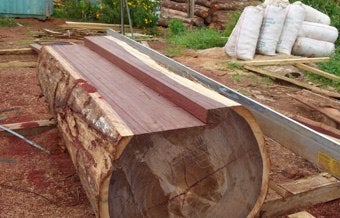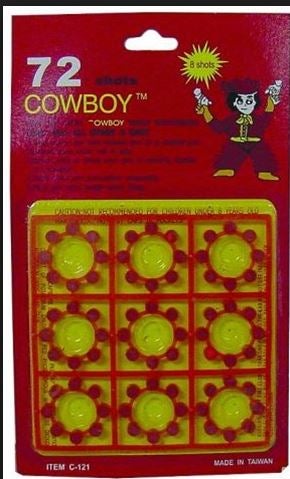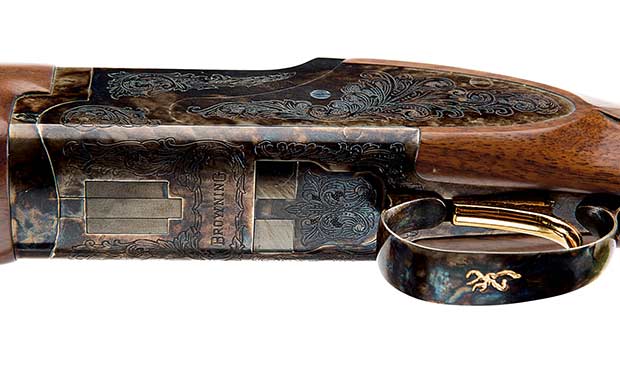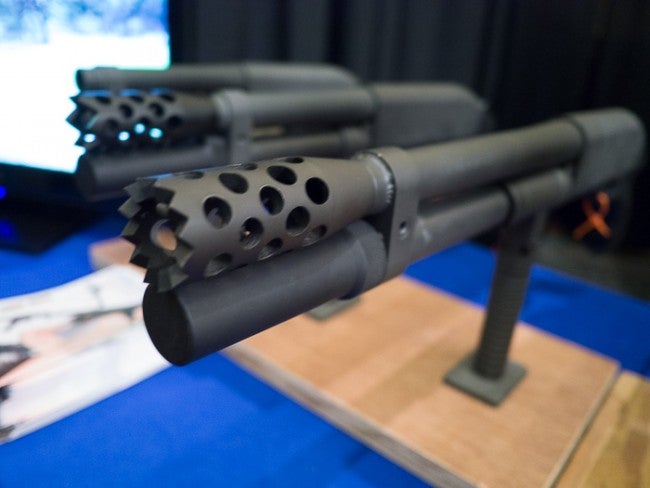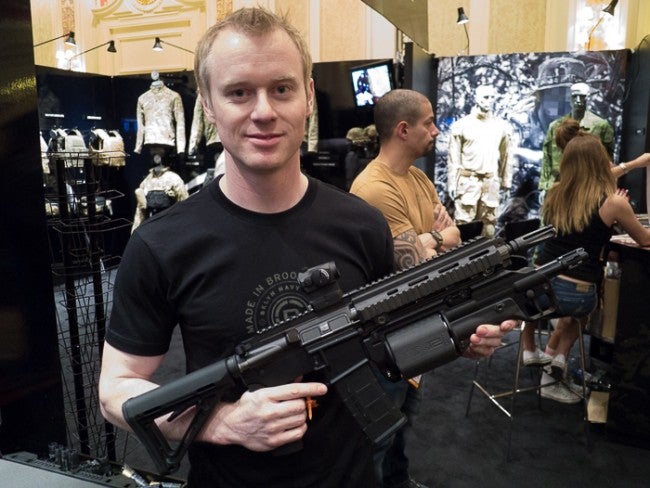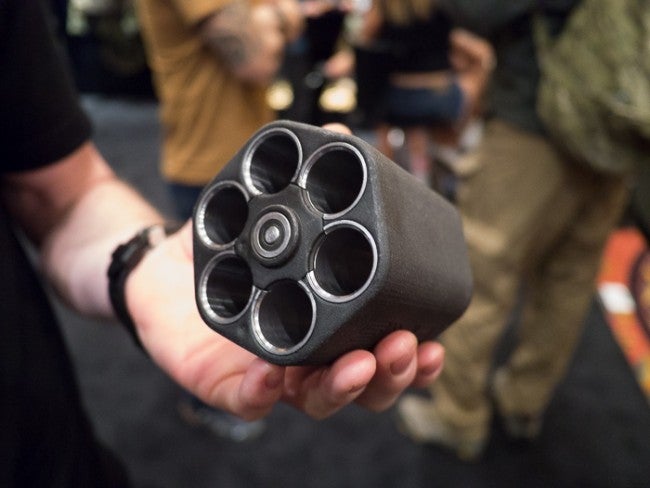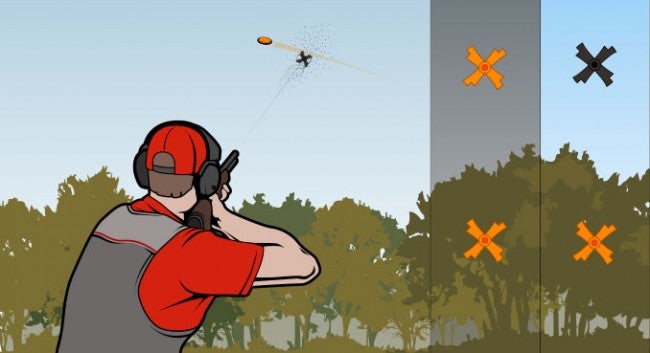![2013-202-660x495]()
Strangely enough, the state of Nebraska has a surprisingly in-depth and comprehensive history of the shotshell hosted on its Game & Parks Commission website. According to this amusingly well-researched compendium, the inventor of the first shotshell is unknown, but we do know that the C.D. Leet Company of Springfield, Massachusetts, is thought to have made the first paper-hull shotshells in at least 1869. By the 1880s, shotshells were being machine-loaded, and between 1887 and 1901, shotshell sales increased seven-fold. Over the years, shotshell technology advanced with the addition of centerfire primers, better powders, and hull materials. And though the “modern” shotshell itself is a half-century old (the first plastic hulls were made in the 1960s), at its core, the shotshell as we know it has stayed relatively the same for well over a century – a rimmed cartridge geared towards breech-loading, with a flat-top hull. Modern pump and semi-auto shotguns have been built around the cartridge, being fed via a tube running under the receiver, diverging from the removable box magazine-fed path taken by the rifle.
While I can only speculate as to why the shotgun became and stayed an almost-exclusively tube-fed weapon, it was certainly a combination of factors, not the least of which is related to the unsuitability of the flat-fronted and rimmed shotshell for box magazine cycling.
We have seen a surge in box mag semi-auto shotguns in recent history, the most notable of which is the Saiga-12 shotgun based loosely upon the Kalashnikov operating system. And though the Saiga enjoys one of the most zealous fan bases and may be one of the most heavily modifiable and popular semi-auto shotguns, I reluctantly opine that, if anything, the Saiga demonstrates well the shortcomings of the 100-plus year old shotshell design in the box mag semi-auto platform.
I owned this Henderson Defense converted Saiga 12 for a few years. Both before and after the conversion, the Saiga was not what I would call a reliable weapon system. Across a range of manufacturers and shotshell sizes, the Saiga was varying degrees of unreliable. Apparently, my experience is not unique: Other authors and reviewers with similar or greater experience have similarly observed the same issues.
Without wading any further into the Saiga debate, either way, it is accepted that rimmed cartridges are not optimal for box magazine feeding. Accordingly, if you want to maximize reliability in a box fed semi-auto shotgun, it stands to reason that introducing a rimless cartridge is your first step. Second, a ball tip case would increase feed reliability up the ramp and into the chamber. The classic, standard shotgun shell has neither.
Intrepid Tactical Solutions has tackled this issue, creating a revolutionary new rimless, ball-tipped 12 gauge shotshell and manufacturing a platform for it, both the shotshell and the shotgun dubbed the “RAS-12″. ITS contacted me about reviewing the RAS-12 shotgun and ammunition, and I enthusiastically accepted the invitation. In my opinion, a shotshell optimized for mag-fed semi-auto operation is a welcome advance. It’s been over a hundred years of the same shotshell, and instead of building the shotgun around the shotshell, it’s well time to capitalize on advances in firearm technology – the hardware itself – and redesign the shotshell for use in advanced semi-auto shotguns.
With that in mind, I received the RAS-12 for review and ran 100 rounds through it, while the RAS-12 is an innovative platform and a relative engineering success, the overarching question is “will it succeed in the marketplace?”
Specifications:
The RAS-12 is an 18″ 12 gauge shotgun upper that fits on a standard AR-10 lower and uses Magpul PMag AR-10 magazines (more on this below). At present, the only ammunition available for it is ITS’s own RAS-12 12 gauge ammunition, which is a rimless, polymer shotgun shell with a cone or ball tip for enhanced loading and feeding. The ITS Buckshot delivers a 9-pellet, 1.1oz payload at 1200fps. More ammunition types are under development.
The RAS-12 comes with a railed handguard, “Scorpion” breaching muzzle device, and one five round Magpul PMag (actually a converted 20rd. Magpul .308 PMag). The RAS-12 uses a piston operating system, and features a “monolithic” 12 gauge bolt carrier. As will be discussed in depth below, the manual of arms is nearly identical to the AR platform, including field-stripping. Unlike other box magazine-fed 12GA semi-auto shotguns, the RAS 12 features an auto bolt hold open, straight insert magazines, and is easy to load and charge on a closed bolt.
![2013-219]()
The massive “monolithic” bolt carrier, bolt inserted.
![2013-220]()
Bolt face, with a quarter for scale.
![2013-221]()
The prodigious gas block on the fore end of the RAS-12.
ITS suggests field-stripping and cleaning the RAS-12 every 100 rounds. The RAS-12 comes with a 1 year warranty. See http://intrepidts.com/index.html for more information.
Also note that the RAS-12 is American-made.
General Observations:
The unquestionable core of the RAS-12 shotgun is the polymer-jacketed ITS RAS-12 shotshell. As you can see from the pictures and the cut-away below, this is a rimless case round with a ball tip.
![2013-209]()
From L-R: a 2 3/4″ 12GA shotshell; a 3″ 12GA shotshell; an RAS-12 00 Buck shotshell, and; a 10GA shotshell.
![]()
A cut-away of the RAS-12 00 Buck round.
ITS claims that the RAS-12 round is the first polymer shotshell designed to “stack vertically and work flawlessly.” And stack vertically it does. The rimless cartridge allows the RAS-12 shotshell to stack five deep into a Magpul .308 PMag. You read that correctly – as seen from the photos, the RAS-12 shotgun comes with an inexpensive and durable modified Magpul PMag that accommodates five RAS-12 rounds with room to spare after installing a new follower (although I am curious if this would work with a standard follower as well). Also, you can almost jam a sixth round in there, which inclines me to believe that a slightly larger .308 magazine like the 25rd. 7.62×51 Magpul PMag might even accommodate seven rounds.
![2013-199]()
The RAS-12 shotgun uses a 20rd. .308 Magpul PMag.
![2013-208]()
This offers an edge over the Saiga in several ways. First, the Saiga is known for expensive and cheaply-made third-party magazines (although the Saiga factory five round magazine is very durable and well-made). Without offering any names, I used to sell a very popular brand of Saiga magazine by the case at a distributor and a dealer level. Almost regularly, magazines bulk-packed in a box would be reported as broken by dealers and customers. The RAS-12 gets around that easily – no flimsy, third-party, proprietary magazines needed, only the renowned and durable PMag that can be purchased for under $20. Second, these mags are straight-insert, which are much easier to manipulate than the rock-and-lock AK style Saiga mags. Third, a PMag full of five RAS-12 rounds has a little play in it. This allows it to be straight-inserted on a closed bolt easily. The first generation magazine I received had a smooth follower and full-length feed lips, and, when fully loaded, the mag would give minor resistance during loading into the mag well. However, before I made it to the range for a second trip, ITS sent the second generation magazine (see pictures below), which appeared to have trimmed feed lips and a modified AR-10 follower, and it loaded smoothly. Compare this to the Saiga, which can be very difficult to load on a closed bolt, and the Saiga further compounds this problem with the lack of a factory bolt hold open. The RAS-12 upper holds the bolt open automatically after the last round is fired, dramatically increasing loading speed.
![2013-12]()
The first generation magazine/follower is on the left, the modified new design is on the right. While the newer design worked perfectly, I imagine it will look cleaner when it goes into production.
![2013]()
The ball tip of the casing splits open when fired, violently delivering its payload to great effect. This is what a pile of expended RAS-12 shells looks like:
![2013-213]()
There are a couple of drawbacks, however. First, the RAS-12 ammo is relatively expensive at $3 a round, although not inordinate. ITS claims that price will go down on ammo as they have received commitments from large manufacturers, including Remington, to make the RAS-12 shell. I suggested that ITS consider allowing the royalty-free manufacture of the round (if you recall, this certainly helped the .300BLK round gain serious traction, while the nearly-identical .300 Whisper remained a wildcat for years before), however, ITS did not seem like they planned to follow my suggestion. I think this may be an error, as the RAS-12 platform is not going to survive if the ammunition is difficult to obtain, however, I am not an economist. Second, one of the ball tips split when the RAS-12 bolt attempted to slam the shell into battery – right into the base of the previously-fired round that failed to eject. And though the cracked round still fed and fired perfectly, it bears mentioning that the ball tips are not very thick.
All said, the RAS-12 shotshell seems a worthy semi-auto counterpart to the revered 12 gauge round, and will not doubt improve rapidly in subsequent iterations. ITS claims that the RAS-12 round can be reloaded like any other 12GA round as well. Performance is good, with the buckshot delivering 9 Buck pellets at 1200fps – more or less the same as 00 Buck from your 18″ Remington 870.
But the effectiveness of the projectile is just as well determined by the effectiveness of the platform firing it. In this case, the RAS-12 shotgun:
![2013-214]()
As I said in the introduction, it is difficult to think of any way that the RAS-12 shotgun could be better-designed or manufactured. As to the manufacture quality, everything fits tightly, lines are clean and sharp, there is almost no evidence of machining, and it just feels like a sturdy and robust platform. Obviously, no expense was spared in the composition and assembly of this weapon.
![2013-215]()
Further still, the design is ingenious. I’ve already told you that it takes PMags, so, of course, the RAS-12 shotgun uses your standard AR-10 lower. This is brilliant, as it basically makes the RAS-12 a quick swap, and better still, it can be bought without going to your FFL so long as you own an AR-10. This RAS-12 came with a DPMS lower.
![2013-218]()
The upper and lower fit tightly, but it is still a very easy two-pin swap. The buffer also needs to be changed out when swapping into the RAS-12 upper, but that only takes seconds. In all, this shotgun will have great appeal to AR-10 owners.
![2013-207]()
The RAS-12 comes equipped with a beefy but sleek railed forearm, as well as a breacher-style “Scorpion” muzzle device.
As you would expect, then, the RAS-12 has a near-identical manual of arms as the AR platform, from the charging handle down to the ping-pong paddle bolt release. The trigger is the same as the AR-10 you swap this RAS-10 on to, likely a standard AR GI single-stage trigger. Obviously, then, the lower can accept new stocks and all accessories available for AR-10 lowers (except buffers, as mentioned), and the RAS-12 upper can accommodate all pic rail accessories.
![2013-216]()
Another view of the rail system.
Firing the RAS-12 is an absolute blast to shoot – I can’t place why it is simply more “fun” than a Remington 11-87 for example. Recoil impulse may have been about the same as my 11-87 Police. However, the standard, plastic M4 stock on my demo gun is not as comfortable compared to the hefty rubberized Speedfeed found on the common 11-87 Police, but a simple AR-stock swap would likely remedy this. A Magpul stock with a thicker recoil pad comes to mind as an excellent substitute. I allowed four other experienced shooters to fire a magazine each, and each of them was absolutely thrilled. Also, this gun barks sound and flame, which certainly adds to the experience.
![2013-206]()
![2013-204]()
Other than that, the shooting experience was exactly like shooting a 12 gauge shotgun from an AR-10 lower: The ergonomics of the AR-10, but with that 12 gauge boom. Brilliant, ingenious, and effective.
Negative Observations:
As a prefatory note, the model I received for evaluation was a prototype, and not a production model. The first gun I received experienced three failures in 50 rounds, however, ITS updated the chamber specs based upon their research, and both myself and our T&E Coordinator, Phil White, fired 50 rounds each through two prototypes with the updated chamber specs, and these guns worked flawlessly. Additionally, ITS has said that this shotgun needs a few range sessions to break in, and I did not have enough ammo to break in either of the guns I received (100 total rounds). Further still, as I do with all test guns unless instructed otherwise, I did not clean or lubricate either the first or second guns before firing them. So, for the sake of full disclosure, I’ll skim over the issues I had with the first iteration, but I re-emphasize that ITS has since changed the chamber specs and seems to have these running flawlessly now, so do not lend too much weight to the following failures:
The RAS-12 I had with the initial, smaller chamber spec experienced three failures in the fifty rounds I fired through it. The first malfunction was a bolt-over-base when the first round from the magazine was loaded via the bolt release/ ping-pong paddle. This can happen occasionally with an AR-style bolt release if the bolt did not fully retract, while still allowing the top round into the action, and this malfunction is typically avoided by charging the gun with the charging handle instead of using the bolt release. Accordingly, I overlooked this malfunction at that moment. That is, until it happened again, but this time in the middle of a magazine. The gun failed to fire in the middle of a firing sequence due to the below-pictured bolt-over-base malfunction:
![2013-210]()
One of two bolt-over-base malfunctions experienced in the 50 round session.
I can only surmise that the malfunction was caused by the bolt carrier’s failure to fully retreat.
Finally, the third malfunction came as a double-feed caused by a failure to extract, as pictured below. The RAS-12 failed to extract a spent casing, but cycled and attempted to feed another round into the occupied chamber:
![2013-211]()
Doublefeed caused by failure to extract.
Strangely enough, after clearing the weapon, the spent casing easily extracted by cycling the charging handle after allowing the bolt to fully close. No defects were noted in the problem casing.
That said, however, two of the most recent, updated versions of the RAS-12 we received cycled 50 rounds each without an issue. One of them was cleaned and lubed before firing, one was not, but both performed well, so it seems that these reliability issues with the initial prototype have been adequately addressed.
Because the recent iteration of this gun seems to be reliable, I don’t place much significance on the issues with the first version of the gun I received. However, there are a couple of observations I have about the system generally:
First, this is not a cheap system. In addition to the $3 rounds, the RAS-12 upper MSRP (including complete upper, one magazine, and buffer/spring) is $1,950. We will see what the actual street price is when production is in full swing. I will say that this is a similar price point for a piston AR upper of comparable quality such as the LMT MRP Piston or the H&K MR556. So while it is pricey, it also seems to be a good value, nonetheless.
Second, this is a pretty heavy system, almost certainly due to the hefty .308 lower and the piston system added to the upper, however, a piston-based 12 gauge is going to have to be robust, so this is expected.
Third, while the manual has cleaning instructions, I did not see nor could I figure out how to remove the piston for cleaning. While I am sure the piston won’t have to be cleaned every range session, someone will have to scrape it eventually, and I would want that someone to be me, not a gunsmith or the factory.
Finally, the RAS-12 rounds could be more robust. While I did not have issues with them generally, the cone of the round that was double-fed into the back of the chambered round did slightly split, although it fed and fired all the same. That said, it’s still a minor point of concern if one were to drop a full magazine on a hard surface.
Conclusion:
As said earlier in this review, it appears that this innovative and creative platform is an engineering success, and production models will presumably be even more improved than the current version of the pre-production prototypes. The RAS-12 feels solid, drips quality, performs well, and is just amazing to shoot. And even though this is a fun range gun, the tactical applications are apparent as well – this is a powerful magazine-fed semi-auto shotgun with the same manual of arms as the venerable and prolific AR-15, and the ability to put this upper on an AR-10 lower and use AR-10 straight-insert magazines (and, therefore, AR-10 mag pouches and gear) will obviously make this upper very easy to transition into any program.
But will it succeed in the market? Many will balk at the proprietary ammo, although ITS would likely argue that this ammo is a necessary advancement in the semi-auto magazine-fed platform. And while that may be the case (and I agree that it is), even a revolutionary round may have a hard time catching on at three dollars a pull. The aforementioned partial mutuality with the AR-10 will certainly make the RAS-12 much more appealing to the gun-buying public, will that be enough? And though we have tested two RAS-12s that performed without issue (at least after the modifications to the earlier prototype), our experience was limited to 150 total rounds, which, though a positive start, hardly cements reliability. Time will tell on this front. All things being equal, I certainly believe that that the present version of the RAS-12 solidly outperforms the Saiga 12, however, the cost of admission to the RAS-12 club will also get you two converted SGL-12s, and moreover, you can feed both of those Saigas for the same price as the ammunition for only one RAS-12.
In closing, the RAS-12 is an excellent performer. Any complaints I have about this gun are very minor. This is a top-end machine, and fit and finish are as good on the RAS-12 as they are on any premium AR manufacturer’s products. Moreover, I believe that, while it won’t replace the 870 anytime soon, the RAS-12 is an advance in technology that should be welcomed and adopted by the shooting public, if anything, to advance the round so that the RAS-12 shells might find their way onto other platforms. The RAS-12 round is truly the next evolution in shotgun ordnance, and I think that the more prolific it becomes, the better for the shooting industry and market as a whole. That said, Intrepid Tactical Solutions has an uphill battle in front of it – to get this RAS-12 in our safes, next to our Mossbergs, Remingtons, and Winchesters. A tough battle indeed, but the RAS-12 likely represents the best shot to meet this lofty goal.






